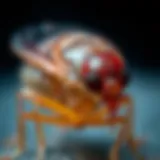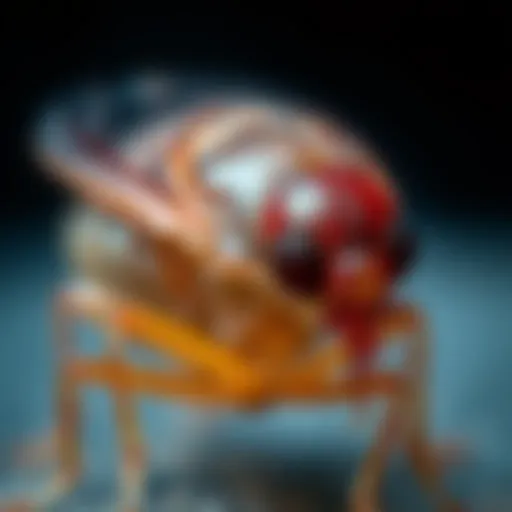Effective Strategies to Deter Possums in Your Home
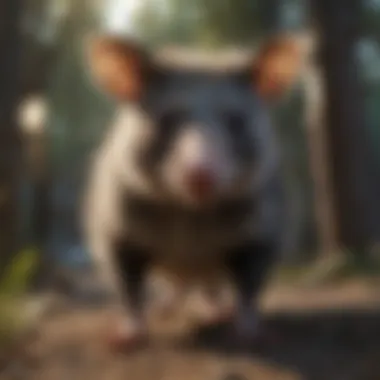

Intro
Possums are nocturnal creatures that can become unwelcome visitors in your home. Understanding how to effectively deter them is crucial for maintaining a safe and peaceful living environment. In this guide, we will explore the behavior of possums, preventive methods, and eco-friendly deterrent techniques. Homeowners, as well as pest control enthusiasts, will find valuable insights into managing possum encounters.
Pest Identification
Identifying possums is the first step in managing their presence. Possums are marsupials with a distinctive appearance. They have a pointed snout, large ears, and a long, hairless tail. Their fur is typically greyish or brown. In addition, possums are about the size of a house cat, weighing anywhere between 5 to 15 pounds.
Common Household Pests
While possums can be a nuisance, it is essential to distinguish them from other household pests. Common pests such as raccoons, squirrels, and rats can share similar habitats with possums. Unlike these species, possums are more solitary and have a unique defense mechanism: playing dead when threatened. Understanding this behavior helps in identifying possum activity.
Signs of Infestation
Several signs can indicate a possum infestation. Homeowners should look for:
- Tracks: Possums have distinct tracks with five toes on each foot.
- Droppings: Their droppings are dark and shaped like a capsule.
- Sounds: Nocturnal activity may be noticed through scratching or rustling noises at night.
It is vital to recognize these signs early to implement effective control measures.
Prevention Methods
Preventing possums from entering your home is a proactive approach. Making environmental modifications and maintaining your home can significantly reduce the likelihood of possum visits.
Environmental Modifications
One effective strategy is to make your environment less inviting. This includes:
- Securing Garbage: Use heavy-duty bins with tight-fitting lids to prevent scavenging.
- Removing Food Sources: Ensure that pet food and other edibles are not left outside.
- Trimming Vegetation: Keep trees and shrubs trimmed to eliminate shelter and pathways into your home.
Home Maintenance Tips
Regular home maintenance is essential. This includes checking for potential entry points around your house. Inspect your attic, crawl spaces, and vents for any openings. Sealing these gaps can prevent possums and other pests from entering.
DIY Pest Control Solutions
Homeowners can also explore DIY pest control solutions. These options include natural remedies and barriers that deter possums without harmful chemicals.
Natural Remedies
Some homeowners prefer non-toxic methods for possum control. Using substances like cayenne pepper or vinegar can be effective. Sprinkling cayenne pepper around potential entry points may deter possums due to the spicy scent.
DIY Traps and Barriers
Building physical barriers can also be beneficial. Simple solutions like fencing or aromatic herb plants can act as deterrents. Consider:
- Fencing: Install a sturdy fence at least four feet high and burrow-proof.
- Barriers: Using wire mesh can block access to attics or crawlspaces.
"A proactive approach in identifying and preventing possum encounters is less stressful than dealing with an infestation."
Closure
Understanding possum behavior and implementing preventive measures can greatly assist in deterring these animals from your property. With the right techniques, homeowners can enjoy a possum-free environment while maintaining harmony with the natural world.
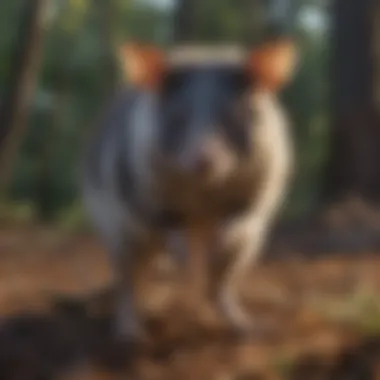

Understanding Possums
Understanding possums is crucial for effective management and deterrence strategies. Possums are often misunderstood creatures that play a significant role in local ecosystems. By gaining insight into their behavioral patterns, habitat preferences, and feeding habits, homeowners can develop informed approaches to prevent potential conflicts. Recognizing their patterns allows for better planning and the implementation of effective deterrents, minimizing damage to properties and gardens while respecting wildlife.
Behavioral Patterns
Possums exhibit unique behavioral patterns that influence their interactions with human environments. Primarily nocturnal, these marsupials are most active during the night. This activity pattern can lead to them being unnoticed while they scavenge for food or seek shelter. They have a tendency to avoid confrontation, often relying on their ability to play dead when threatened. Understanding this timid nature can guide homeowners in selecting humane solutions to deter them.
Possums communicate through an array of vocalizations and body language, signaling distress, mating, or territorial disputes. Homeowners should be aware of these signals, as they can indicate the presence of possums nearby, allowing for timely action to be taken. Creating a disturbance, such as noise or light, can disrupt their activities without causing harm.
Habitat Preferences
Possums tend to favor habitats that offer both shelter and food sources. They are adaptable and can thrive in urban, suburban, and rural environments. In urban settings, they often make homes in attics, garages, or under decks, seeking warmth and security. Meanwhile, suburban areas provide a mix of trees and shrubs that serve both for shelter and food.
Their preference for locations with access to food is notable. Gardens, compost heaps, and pet food left outside can attract possums. Reducing these attractants is essential for managing possum populations effectively. Homeowners can focus on creating environments less appealing to possums through smart landscaping choices and proper waste management.
Feeding Habits
Possums are omnivorous, with a diverse diet that includes fruits, vegetables, insects, and small animals. Their foraging behavior is opportunistic, meaning they will eat whatever is readily available. This adaptability allows them to thrive in various settings, especially where human food sources are accessible.
To deter possums effectively, understanding their feeding habits is critical. Homeowners should consider the following strategies to minimize food availability:
- Secure Garbage Bins: Use tightly sealed containers to prevent easy access.
- Remove Pet Food: Bring pet bowls inside at night to eliminate food sources.
- Garden Management: Cover crops and remove fallen fruits regularly.
By limiting their food sources, homeowners can create less inviting conditions for possums, encouraging them to seek sustenance elsewhere. Understanding these feeding habits lays the groundwork for more effective deterrent strategies.
Identifying Possum Issues
Identifying possum issues is a crucial step in managing potential conflicts between these marsupials and homeowners. Understanding the signs of their presence can prevent future infestations and damage. This section elaborates on recognizing the evidence of possum activities, assessing damage in gardens, and comprehending their habitats.
Signs of Possum Activity
Detecting signs of possum activity early can save time and resources. Common indicators include:
- Droppings: Possum droppings are dark and cylindrical, often found under trees or near food sources.
- Tracks: Possums have five toes on each foot, and their prints are about the size of a child's hand. Look for claw marks in soft soil.
- Scratching Sounds: Listen for scratching noises at night. Possums are nocturnal, and sounds in attics or around garbage can indicate their presence.
- Damaged Plants: If leaves are munched on or stems are broken, consider the possibility of possums feeding.
Recognizing these signs allows homeowners to act swiftly, reducing the likelihood of more significant issues in the future.
Assessing Damage in Gardens
Once possum activity is confirmed, it is vital to assess the extent of any damage occurring in gardens. Owners should examine:
- Plants: Look for chewed leaves or uprooted plants. This can indicate the species of plants they prefer.
- Fruits and Vegetables: Possible consumption and the extent of loss can inform the level of infestation. Possums tend to favor ripe fruits.
- Structures: Check for damage to fences and trellises. Strctural integrity can be compromised if possums gain access.
This assessment will help in directing appropriate deterrent methods based on the damages encountered.
Understanding Possum Habitats
Knowing where possums live is essential for effective management strategies. Possums favor:
- Wooded Areas: These provide shelter and food sources. Understanding nearby environments helps gauge the likelihood of possum visits.
- Urban Gardens: Urbanization has led possums to seek food in gardens and refuse. Familiarizing oneself with local populations can result in tailored deterrents.
- Nesting Sites: Look for potential nesting spots such as attics, garages, and under decks. Eliminating access to these areas reduces future encounters.
Understanding their habitats aids homeowners in not only recognizing potential problems but adopting preventive measures. Addressing these factors holistically leads to a sustainable approach in managing possum issues.
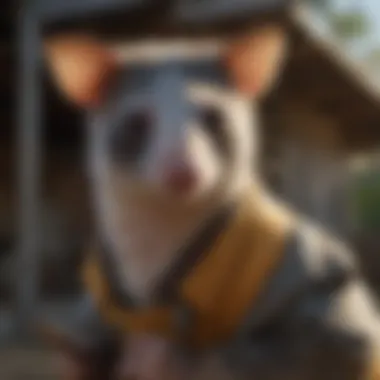

Using Physical Deterrents
The use of physical deterrents plays a crucial role in managing possum populations. These methods aim to prevent possums from accessing your property without causing them harm. Beyond keeping your garden intact, physical deterrents are often more sustainable compared to chemical solutions. They tend to be eco-friendly, which aligns with many homeowners’ values today. By employing physical barriers and securing attractants, you can effectively reduce possum visits.
Fencing Techniques
Fencing serves as one of the most effective physical deterrents against possums. The type of fence you choose significantly impacts the overall effectiveness of your possum control strategy.
Types of Fences
When considering types of fences, several options are available. Each type has its own merits and drawbacks. A solid fence can provide a reliable barrier. Designed to be tall and impenetrable, a solid fence can deter possums, as they prefer not to climb over such structures.
On the other hand, a chain-link fence offers visibility while still acting as a barrier. Although not as strong, they can be effective if installed with the right height and additional deterrents.
One unique option is the electric fence. This type can be beneficial in areas where other fences may have failed. They create a mild electric shock that discourages possums from trying to breach the barrier. However, proper installation and maintenance are crucial to ensure efficacy.
Potential disadvantages include initial cost and ongoing power requirements.
Height and Structure
The height and structure of a fence can greatly influence its effectiveness against possums. Generally, a fence that is at least 1.5 meters high can deter these creatures. Possums are not strong jumpers, and high structures provide a crucial advantage.
The structure should also be designed to prevent climbing. Features such as overhangs can be very useful here. If a fence has a slight incline towards the outside, it makes climbing more challenging for possums.
Like any solution, some downsides exist. Fences need regular maintenance to remain effective. Over time, wear and environmental factors can compromise their integrity.
Securing Trash Bins
Securing trash bins is another effective physical deterrent. Possums are omnivorous scavengers. They are attracted to easily accessible food sources, especially in urban and suburban settings. When trash bins are left unsecured, they invite possums to rummage through the leftovers, encouraging frequent returns.
To prevent this, opt for locking lids or latching mechanisms on your trash bins. Additionally, you might consider placing your bins in a secluded or less accessible area. Using heavier containers can also deter possums, as they find it more difficult to move or tip over these bins.
Simply adapting these two strategies can significantly reduce possum visibility on your property.
Taking proactive measures like fencing and securing trash can reduce the risk of possums settling in your garden.
Through using physical deterrents strategically, homeowners can establish a less inviting environment for possums, which can lead to long-term management success.
Chemical Deterrents
Chemical deterrents play a crucial role in managing possum populations around residential areas. These products can create a barrier that prevents possums from invading gardens and homes. Understanding these chemicals is important, as they can provide effective solutions when physical barriers or other methods may fall short. A significant advantage of using chemical deterrents is their ease of application. Many homeowners find chemical solutions less labor-intensive than physical barriers.
Commercial Repellents
Commercial repellents are widely available and often formulated specifically for deterring possums. These products typically contain active ingredients derived from plant oils or synthetic chemicals designed to create unpleasant odors for the animals. When choosing a commercial repellent, it is essential to follow the instructions for safe application rigorously. Most repellents are sprayed around plants, entry points, or affected areas to discourage possum visits. One clear benefit of commercial repellents is their consistent effectiveness, as they are manufactured through rigorous testing.
Homemade Solutions
Homemade solutions present an attractive option for those looking to avoid commercial products. These alternatives can be cost-effective and, in many cases, environmentally friendly.
Natural Ingredients
The use of natural ingredients in homemade solutions is interesting. Many people prefer these options for their safety and lower impact on the environment. Ingredients such as garlic, citrus peels, and chili powder can be part of an effective deterrent mix. Garlic, specifically, is often cited for its strong odor, which possums typically dislike. A key characteristic of natural ingredients is their accessibility; many can be found in most households. While they may not be as potent as commercial repellents, their advantage is derived from their non-toxic nature, making them popular choices among environmentally conscious individuals.
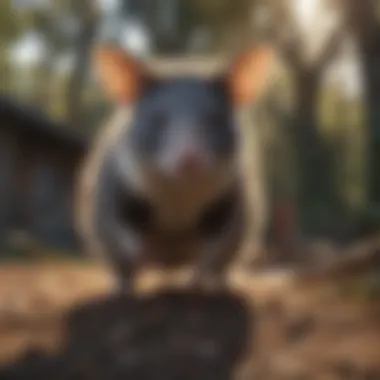

Application Methods
When it comes to application methods, they can significantly affect the effectiveness of homemade solutions. For instance, combining natural ingredients with water in a spray bottle allows for easy and even distribution. The key advantage of this method is its simplicity; anyone can execute it without specialized tools. However, the unique feature of such methods is that they may require more frequent reapplication compared to commercial products, especially after rain. Despite the potential for increased effort, many homeowners appreciate the flexibility and tailor-made nature of homemade repellent solutions.
Environmental Considerations
Understanding the environmental considerations in managing possums is crucial. It ensures that homeowners adopt methods that not only deter possums but also protect other wildlife and ecosystems. Deterrent methods can impact local flora and fauna, often in unforeseen ways. For instance, while certain repellents may keep possums at bay, they might also cause distress to birds or beneficial insects. Thus, a thoughtful approach is necessary to cultivate a harmonious living space.
Impact of Deterrents on Local Wildlife
When employing any form of deterrent, it is vital to assess its effects on non-target species. Some products or practices intended for possum deterrence can inadvertently harm other wildlife. For instance, chemical repellents can linger in the environment, affecting soil health and potentially disrupting the food chain. Additionally, physical barriers might block access for other animals, which could lead to unintended consequences in local wildlife dynamics.
"Effective pest management is not only about controlling a specific species but considering the broader ecological picture."
Homeowners should therefore try to use deterrents that are specific to possums while being non-invasive to other species. Utilizing natural methods such as planting certain herbs that possums dislike may evoke less risk to surrounding wildlife. Furthermore, checking for any unintended side effects post-implementation of deterrent strategies is essential for long-term environmental balance.
Sustainable Practices
Adopting sustainable practices in possum management leads to ecologically sound solutions that benefit homeowners and the environment. These practices often emphasize using resources that minimize harm to ecosystems. By focusing on sustainability, homeowners contribute to the preservation of biodiversity while effectively managing possum populations.
Eco-Friendly Deterrent Options
Eco-friendly deterrent options represent a popular choice among homeowners seeking to harmonize pest control with environmental stewardship. These methods often use natural ingredients, such as vinegar or citrus peels, which can repel possums without causing significant harm to other wildlife. One key characteristic is that these solutions are biodegradable, leading to less pollution and long-term safety for the surrounding ecosystem. Utilizing such deterrents can also help in maintaining a clean and healthy outdoor environment, further enhancing the appeal of one’s property.
Biodiversity Considerations
Biodiversity considerations highlight the importance of protecting various species within an ecosystem while managing possum issues. Welfare of different wildlife species is an integral factor in developing any deterrent strategy. A significant benefit of considering biodiversity is the potential for increased resilience of ecosystems. Grounding deterrent practices on principles that prioritize the survival and health of all species helps promote balanced ecosystems. This synergy can lead to more sustainable and thriving neighborhoods.
Homeowners should therefore be responsible in their approach to managing possums, weighing the ecological impacts of their decisions. By choosing environmentally sound methods, one can effectively deter possums while fostering the rich biodiversity that benefits everyone's living environment.
Long-Term Possum Management
Long-term possum management plays a crucial role in maintaining a harmonious living environment within residential areas. It is about creating sustainable strategies that prevent possums from becoming a recurring nuisance. Residents often confront possum issues, leading to damage in gardens and disturbances in homes. Therefore, implementing effective long-term management practices benefits homeowners while ensuring wildlife conservation.
One significant element of long-term management is monitoring and assessment. Regularly evaluating the presence of possums and their activity ensures that strategies remain effective and relevant. Homeowners who commit to ongoing observation can adjust their methods according to the specific possum behaviors observed in their area. This proactive approach reduces the likelihood of serious infestations, which can lead to higher costs and more invasive solutions later on.
Another vital aspect is engaging in community practices. Possum management should not solely reside within individual households. Community involvement enhances the effectiveness of deterrents through cooperative measures. Working together allows neighborhoods to share insights, resources, and experiences, ultimately fostering a sense of collective responsibility.
The benefits of long-term possum management are manifold. By prioritizing sustainable approaches, homeowners can protect their property and support the local ecosystem. Maintaining native plants and habitats helps strike a balance between living spaces and wildlife needs. Therefore, a thoughtful strategy ensures less reliance on harmful practices, contributing positively to both local biodiversity and personal peace of mind.
Monitoring and Assessment
Monitoring and assessment are fundamental for anyone looking to manage possums effectively over the long term. This ongoing process involves routinely checking for signs of activity and damage. Detection of specific behaviors, such as feeding or nesting patterns, can inform homeowners about the scale of the possum presence.
Homeowners should familiarize themselves with common indicators of possum activity. These might include droppings, chewed plants, scratched trees, and broken fences. Increased awareness of these signs enables quicker response measures. An assessment can also involve examining the effectiveness of previously utilized deterrents. Evaluating whether physical barriers, chemical solutions, or environmental adjustments produced the desired outcomes aids in refining future strategies.
Community Practices
Engaging in community practices enhances the overall effectiveness of possum management strategies. When neighborhoods come together, they create a fortified barrier against potential possum invasions. This community-led effort can manifest in several ways:
Collaborative Approaches
One key characteristic of collaborative approaches is joint action. By working together, residents can optimize their possum management efforts. This collaboration can include shared fencing initiatives or communal efforts to eliminate attractive food sources. The strength of collaborative practices lies in their capacity to produce a unified deterrent effect.
Such practices are beneficial as they foster shared knowledge among community members. Each person can offer experiences and techniques that have proven successful. The unique feature of a collective is its ability to cover larger areas than individual efforts usually could, therefore making them popular choices for fostering a possum-free home environment.
Sharing Resources
Sharing resources relates directly to the efficient use of materials and knowledge within a community. This practice encourages neighbors to pool together their tools, expertise, and even information about local wildlife. For instance, hiring a pest control professional can be cost-effective when shared among several households.
The key benefit of resource-sharing is its ability to lower the financial burden on individual homeowners. Unique aspects of this approach include access to various deterrents and equipment that may not be feasible for individuals to buy outright. However, reliance on communal efforts should always be balanced with personal responsibility. Each homeowner must continue to play their part to ensure lasting success in possum management.








